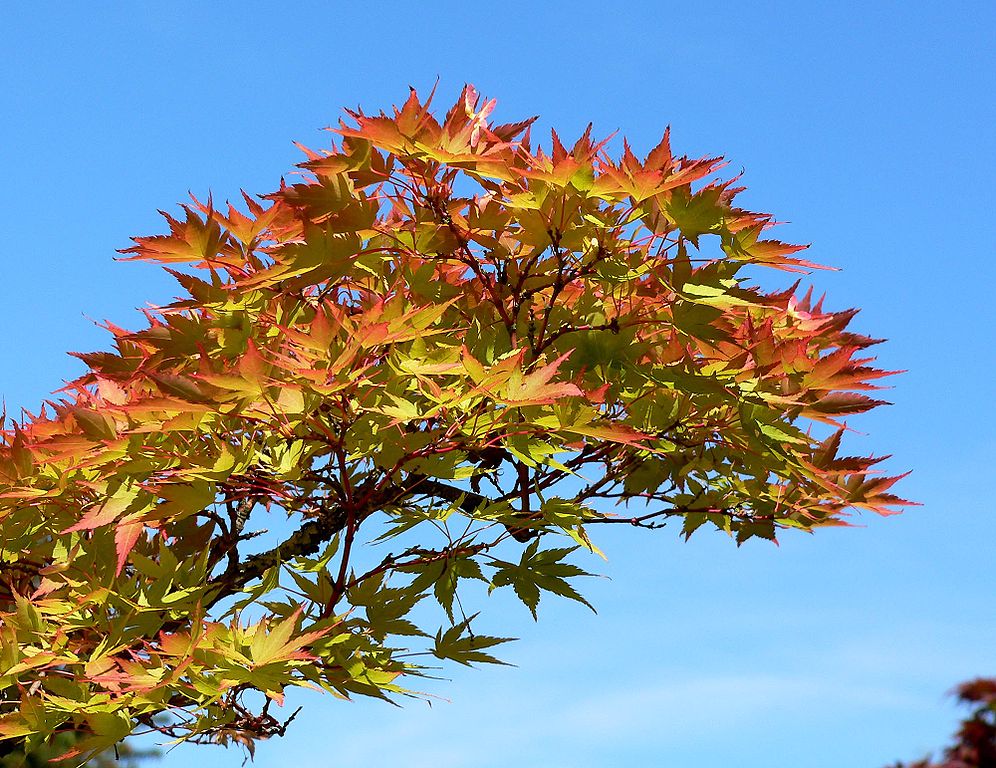This is the final segment of a three part series on Japanese maple cultivars.
Introduction
Japanese maple is a species of tree often used for cultivation. For over three centuries, Japanese horticulturalists have developed cultivars from maples found in Japan, Korea, and China. Cultivars are available for commercial use in retail stores and garden centers across Europe and North America. The following examines some of the most frequently selected cultivars of Japanese maple, including ‘Red Filigree Lace’, ‘Red Pygmy’, ‘Sango Kaku’, Seiryu’, ‘Shaina’, ‘Shindeshojo’, ‘Shishigashira’, ‘Tamukeyama’, ‘Trompenburn’, and ‘Tsuma-gaki’.
‘Red Filigree Lace’: ‘Red Filigree Lace’ is one of the smallest red maple cultivars, attaining a height and width of 5 feet. It grows in a pendulous fashion. The leaves are extremely dissected, giving them a lacy appearance. Each leaf has seven finely cut lobes. Leaves emerge a deep purple-red shade. They retain their color throughout the summer, before turning a bright crimson in fall.
‘Red Pygmy’: ‘Red Pygmy’ is a dwarf cultivar that slowly reaches a height and width of 8 feet. It has a rounded, densely branched habit, and narrow strap-like leaves. Each leaf has seven lobes. They emerge pink-red in spring, turning a greenish-red by summer. In fall, they brighten to shades of orange-red and gold.
‘Sango Kaku’: ‘Sango-kaku’ is an upright, slow growing cultivar that has a vase-shaped form. It can reach heights of 20 to 25 feet, with a 15 to 20 foot spread. It is commonly referred to as coral bark maple due to its attractive pink bark, which provides contrast to landscapes in winter. The pink bark is not as conspicuous in summer; in fact, the coloration may be entirely absent. Pink coloration also occurs on young twigs and branches. Small reddish-purple flowers appear in spring, followed by winged fruits. Palmate leaves emerge yellow-green with reddish serrate margins. Leaves have five to seven lobes, and often resemble ferns. By fall, leaves turn yellow and gold.
‘Seiryu’: ‘Seiryu’ is a unique cultivar: it is the only dissected Japanese maple with an upright form. ‘Seiryu’ may grow between 10 and 15 feet in height, with an 8 to 12 foot spread. It produces small reddish-purple flowers in spring, as well as deeply cut leaves that emerge light green with reddish tipped edges. Leaves turn green in summer. They display hues of red, gold, and orange in fall.
‘Shaina’: ‘Shaina’ is a small Japanese maple cultivar. It is a slow grower that reaches 6 to 8 feet in height, with an 8 to 10 foot spread. It establishes a dwarf, compact form, and a bushy, tufted habit. Bright red foliage emerges in spring, deepening to a dark maroon throughout summer. In fall, leaves turn a brilliant red.
‘Shindeshojo’: ‘Shindeshojo’ is a small, slow-growing plant that has an upright, rounded form. It grows between 5 and 10 feet in height and width. Small reddish flowers emerge in spring. ‘Shindeshogo’ produces some of the best red spring foliage of any available cultivars. The small palmate leaves are divided into 5 or 7 ovate lobes with serrate margins. Leaves are initially crimson red, gradually fading to reddish green, and finally green by summer. Leaves turn shades of red and orange in fall. The bark on young stems is reddish brown.
‘Shishigashira’: ‘Shishigashira’ is a compact, upright cultivar with a slow growth habit. It reaches between 7 and 15 feet in height, with a 5 to 12 foot spread. Small reddish-purple flowers bloom in spring, followed by winged fruits that ripen throughout late summer and fall. Leaves are crinkled and palmate, with five or seven lobes. They emerge bright green, growing in tufts. Leaves retain their color until fall, when they turn gold and crimson.
‘Tamukeyama’: ‘Tamukeyama’ is a dissected cultivar that has a mounded or dome-like form. It grows between 6 and 8 feet in height, with an 8 to 12 foot spread. ‘Tamukeyama’ produces small reddish-purple flowers in spring, followed by winged fruits. Leaves are deeply cut and dissected. They emerge shades of purple and red, before turning a brighter red in fall.
‘Trompenburn’: ‘Trompenburn’ is a small tree with an upright growth habit. It develops at a slow rate, reaching a height of 15 to 25 feet, with a 10 to 15 foot spread. Leaves emerge a dark reddish-purple in spring, retaining their color until late summer, whereupon they fade to reddish-green and bronze. In fall, leaves turn a deep shade of crimson. Leaves are palmate, with 7 or 9 long, narrow to ovate lobes that are deeply cut, and sharply serrated. The lobes are divided close to the base of the leaf.
‘Tsuma-gaki’: ‘Tusma-gaki’ is a small rounded cultivar that reaches a height of 5 to 10 feet, with a 4 to 8 foot spread. It is notable for its palmate leaves that emerge a light yellow-green with red-tipped lobes. Each leaf has 5 or 7 lobes that are toothed, and moderately cut. The lobes are divided about half way to the leaf base. Leaves turn green in summer before transitioning to red and yellow in fall.
Photo provided courtesy of Stan Shebs, and is available for reuse under the Creative Commons Attribution-Share Alike 3.0 Generic License.
